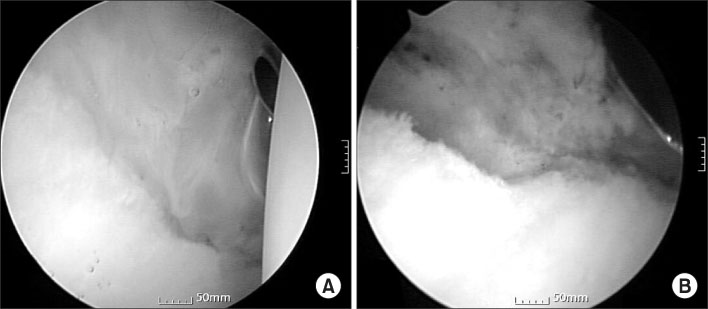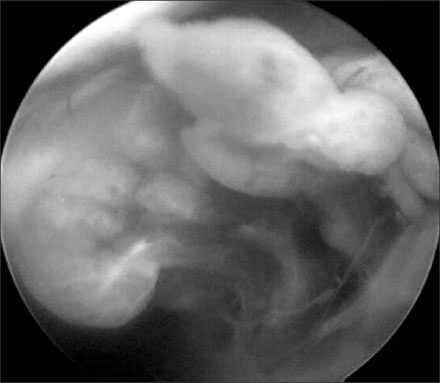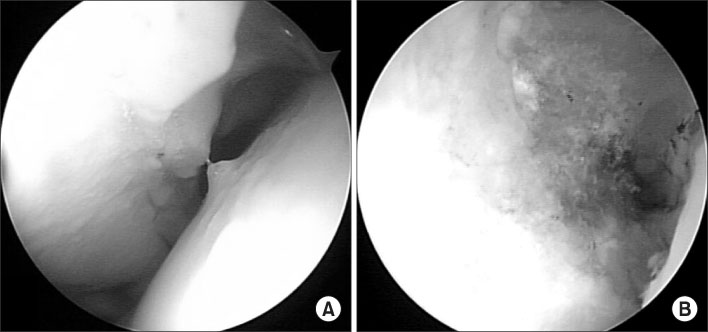J Korean Orthop Assoc.
2009 Aug;44(4):480-485.
Second-look Hip Arthroscopy after Arthroscopic Labrectomy of the Hip: Preliminary Report
- Affiliations
-
- 1Department of Orthopaedic Surgery, School of Medicine, Chungnam National University, Daejon, Korea. dshwang@cnu.ac.kr
Abstract
- PURPOSE
To evaluate the cause of sustained symptoms after previous hip arthroscopy through second-look hip arthroscopy. MATERIALS AND METHODS: From 243 cases of acetabular labrectomy performed in our hospital from 1995 to 2007, we selected for review 9 cases, that had possible follow-up of more than 12 months with second-look hip arthroscopy. The male to female ratio was 3:6, the mean age was 32.2 years, and the mean follow-up period was 19.9 months. We evaluated the cause of sustained symptoms by comparing previous radiographs and second-look arthroscopic findings, and compared the pre-second-look and post-second-look state through physical examination, using the Japanese Orthopedic Association (JOA) pain score. RESULTS: We performed additional osteoplasty or chondroplasty in 6 cases of femoroacetabular impingement, that were due to previously insufficient arthroscopic treatment. Second-look hip arthroscopy revealed 6 cases with labral adhesions, 4 with synovial hypertrophy, 4 with a remnant labral tear, and 1 with a posterior periacetabular cyst. We did a procedure to release the labral adhesion, a synovectomy for the synovial hypertrophy, a labrectomy for the remnant labral tear and a cystectomy for the periacetabular cyst. Secondary arthroscopic treatment showed a post-operative improvement in the range of motion, in 5 cases and the JOA pain score increased improved from 0 to 2, indicating less pain, in all 9 cases. CONCLUSION: The most common cause of a second-look hip arthroscopy is post-operative, sustained femoroacetabular impingement and insufficient labrectomy and labral adhesion. To prevent failure of the arthroscopic treatment, adequate osteoplasty for femoroacetabular impingement, accurate labrectomy for labral tears and constructive rehabilitation treatment for preventing post-operative labral adhesion are recommended.
Keyword
MeSH Terms
Figure
Reference
-
1. Byrd JW, Jones KS. Adhesive capsulitis of the hip. Arthroscopy. 2006. 22:89–94.
Article2. Kelly BT, Weiland DE, Schenker ML, Philippon MJ. Arthroscopic labral repair in the hip: surgical technique and review of the literature. Arthroscopy. 2005. 21:1496–1504.
Article3. Kelly BT, Williams RJ III, Philippon MJ. Hip arthroscopy: Current indications treatment options, and management issues. Am J Sports Med. 2003. 31:1020–1037.
Article4. McCarthy JC. Hip arthroscopy: when it is and when it is not indicated. Instr Course Lect. 2004. 53:615–621.5. McCarthy JC, Lee JA. Hip arthroscopy: Indications and technical pearls. Clin Orthop Relat Res. 2005. 441:180–187.6. McCarthy JC, Lee JA. Hip arthroscopy: Indications, outcomes and complications. Instr Course Lect. 2006. 55:301–308.7. Bartlett CS, DiFelice GS, Buly RL, Quinn TJ, Green DS, Helfet DL. Cardiac arrest as a result of intraabdominal extravasation of fluid during arthroscopic removal of a loose body from the hip joint of a patient with an acetabular fracture. J Orthop Trauma. 1998. 12:294–299.8. Clarke MT, Arora A, Villar RN. Hip arthroscopy: complications in 1054 cases. Clin Orthop Relat Res. 2003. 406:84–88.
Article9. Griffin DR, Villar RN. Complications of arthroscopy of the hip. J Bone Joint Surg Br. 1999. 81:604–606.
Article10. Sampson TG. Complications of hip arthroscopy. Clin Sports Med. 2001. 20:831–835.
Article11. Philippon MJ, Schenker ML, Briggs KK, Kuppersmith DA, Maxwell RB, Stubbs AJ. Revision hip arthroscopy. Am J Sports Med. 2007. 35:1918–1921.
Article12. Robertson WJ, Kadrmas WR, Kelly BT. Arthroscopic management of labral tears in the hip: a systematic review of the literature. Clin Orthop Relat Res. 2007. 455:88–92.13. Harris WH. Traumatic arthritis of the hip after dislocation and acetabular fractures: treatment by mold arthroplasty. J Bone Joint Surg Am. 1969. 51:737–755.14. Shima Y. Standard for evaluation of osteoarthritis of the hip. J Jpn Orthop Assoc. 1971. 45:813–833.15. Hwang DS, Kim YM, Kim KC, Ahn SH. Arthroscopic treatment of acetabular labral tears: 2 to 7 year follow up. J Korean Hip Assoc. 2004. 16:31–40.16. Hwang DS, Lee CH, Lee CH. Arthoscopic treatment of osseous abnormalities as a cause of femoroacetabular impingement: preliminary clinical results. J Korean Orthop Assoc. 2006. 41:778–784.17. Heyworth BE, Shindle MK, Voos JE, Rudzki JR, Kelly BT. Radiologic and intraoperative findings in revision hip arthroscopy. Arthroscopy. 2007. 23:1295–1302.
Article18. Wenger DE, Kendell KR, Miner MR, Trousdale RT. Acetabular labral tears rarely occur in the absence of bony abnormalities. Clin Orthop Relat Res. 2004. 426:145–150.
Article19. Beck M, Kalhor M, Leunig M, Ganz R. Hip morphology influences the pattern of damage to the acetabular cartilage: femoroacetabular impingement as a cause of early osteoarthritis of the hip. J Bone Joint Surg Br. 2005. 87:1012–1018.
- Full Text Links
- Actions
-
Cited
- CITED
-
- Close
- Share
- Similar articles
-
- Comprehensive Review of Advancements in Hip Arthroscopy
- Arthroscopy of the Hip Joint: Diagnosis and Treatment
- Clinical Experiences of the Hip Arthroscopy
- Clinical Application of Hip Arthroscopy in Degenerative Osteoarthritis
- Hip Arthroscopy of a Painful Hip with Borderline Dysplasia: Letter to the Editor




